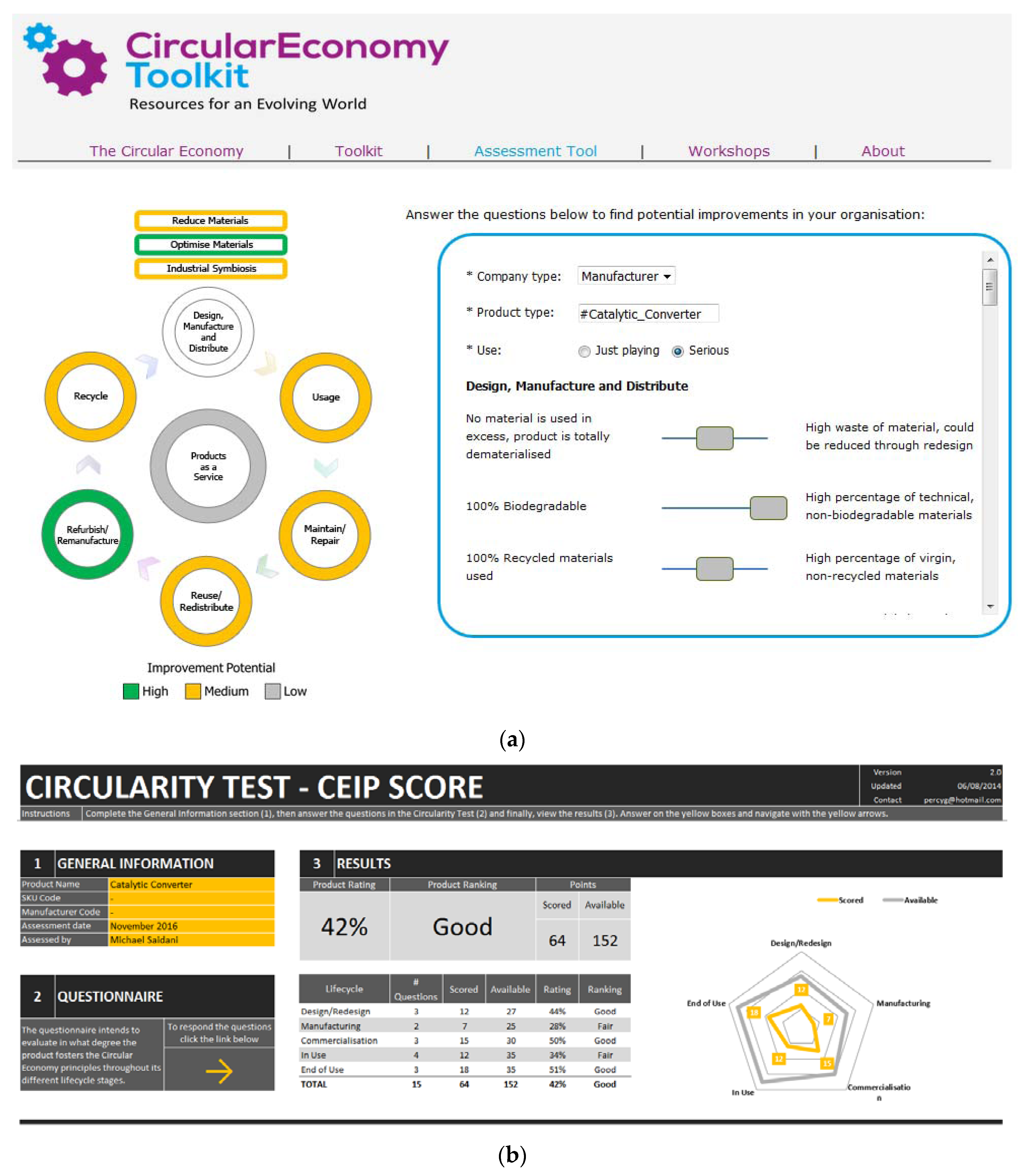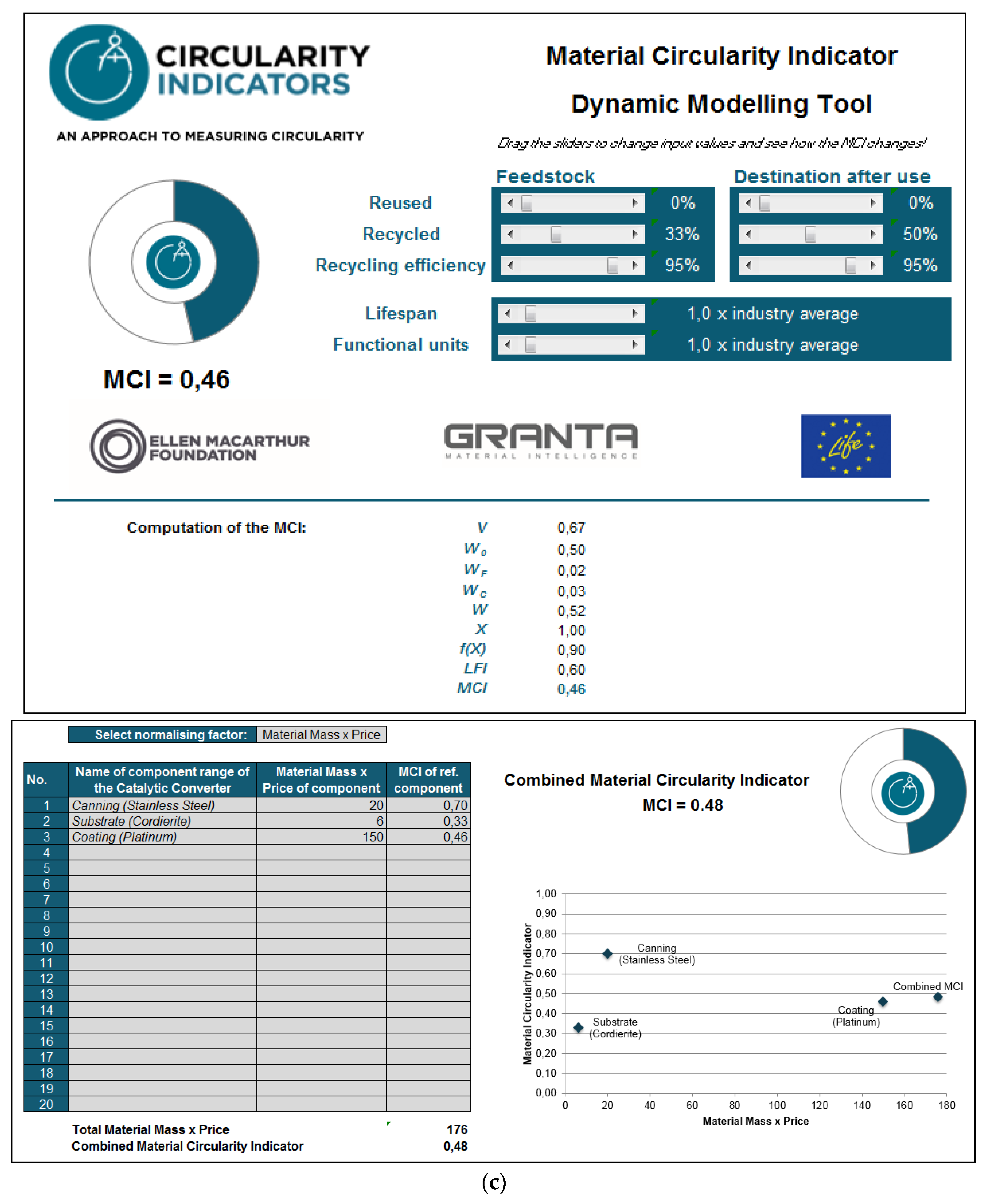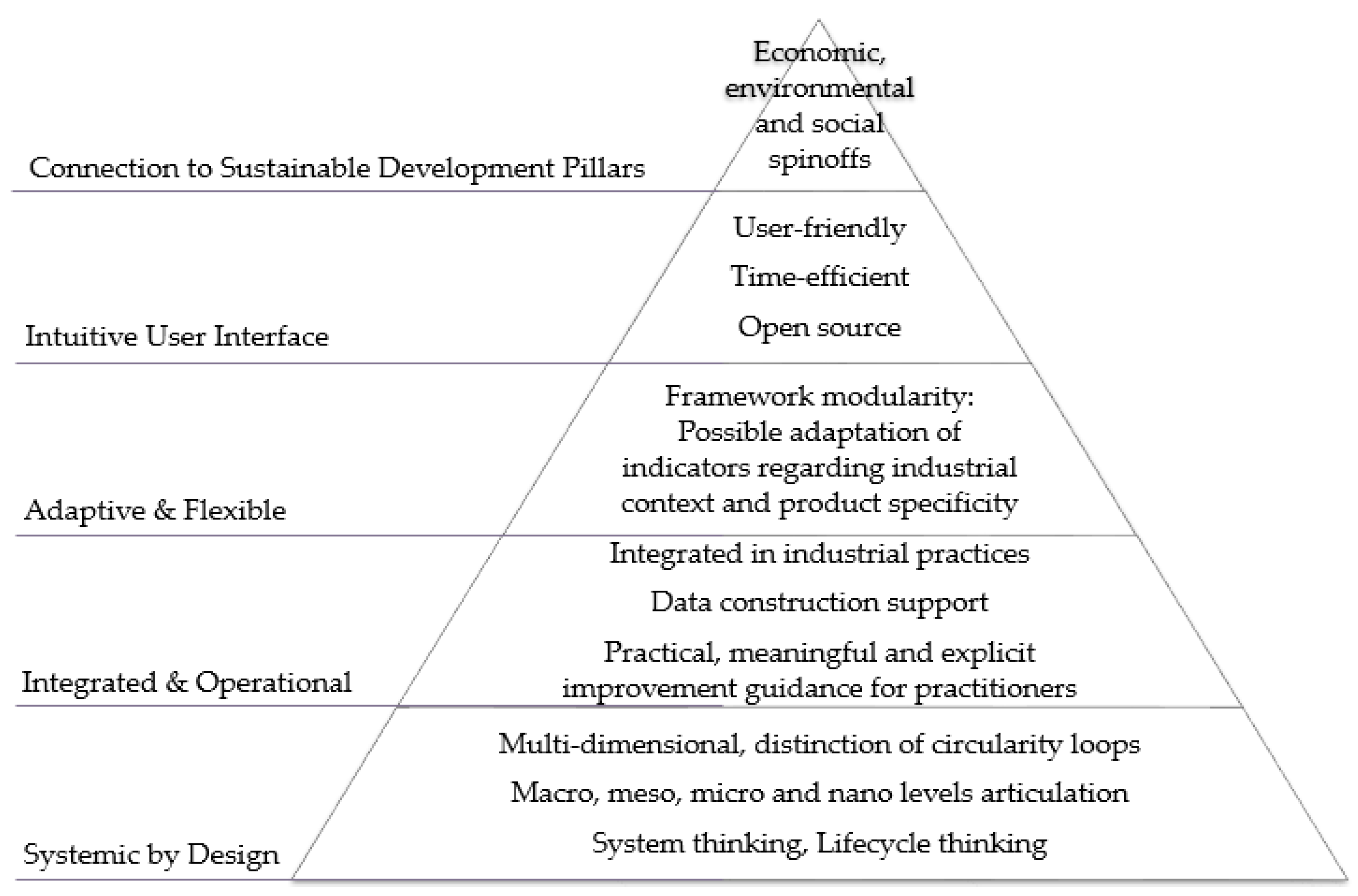How to Assess Product Performance in the Circular Economy? Proposed Requirements for the Design of a Circularity Measurement Framework
Abstract
:1. Introduction
2. Literature Review—The Measurement of Circularity, an Area in Question and in Development
2.1. Positioning on Circular Economy Definitions: Prerequisite for the Rest of This Article
2.2. Joint Agreement on the Need to Assess Circular Economy Performance
2.3. Different Levels of Circular Economy Measurement
2.4. Existing Indicators, Methods and Tools to Measure Product Circularity
3. Results—Comparison of Existing Tools to Measure Product Circularity
3.1. Tools Description, Characteristics, and Modus Operandi
3.2. Case Study: Tools Experimentation Based on a Real Industrial Product
3.3. Critical Analysis: Strengths, Weaknesses and Limitations of Existing Tools
4. Discussion—Proposed Requirements, Practical Implications and Recommendations
4.1. Proposed Requirements for Product Circularity Measurement Framework
4.2. Practical Implications and Guidance for the Design of such a Framework
4.3. Positioning of the Three Tools in Regard to the Proposed Requirements
5. Conclusions—Contributions, Limitations and Call for Further Works
Acknowledgments
Author Contributions
Conflicts of Interest
References
- Ellen MacArthur Foundation (EMF). Schools of Thought. Available online: https://www.ellenmacarthurfoundation.org/circular-economy/schools-of-thought (accessed on 1 February 2017).
- Sauvé, S.; Bernard, S.; Sloan, P. Environmental sciences, sustainable development and circular economy: Alternative concepts for trans-disciplinary research. Environ. Dev. 2016, 17, 48–56. [Google Scholar] [CrossRef]
- Ellen MacArthur Foundation (EMF). Towards the Circular Economy—Economic and Business Rationale for an Accelerated Transition; Ellen MacArthur Foundation: Cowes, UK, 2013; Chapter 3. [Google Scholar]
- European Commission (EC). Communication from the Commission to the European Parliament, the Council, the European Economic and Social Committee and the Committee of the Regions: Towards a Circular Economy: A Zero Waste Programme for Europe. COM (2014) 0398; European Commission (EC): Brussels, Belgium, 2014. [Google Scholar]
- European Commission (EC). Communication from the Commission to the European Parliament, the Council, the European Economic and Social Committee and the Committee of the Regions: Closing the Loop—An EU Action Plan for the Circular Economy. COM (2015) 614/2; European Commission (EC): Brussels, Belgium, 2015. [Google Scholar]
- Accenture Strategy. Gaining an Edge: Growth, Innovation and Customer Value from the Circular Economy. Available online: https://www.accenture.com/us-en/insight-circular-economy-gaining-edge (accessed on 1 March 2017).
- McKinsey Global Institute (MGI). Europe’s Circular Economy Opportunity. Available online: http://www.mckinsey.com/business-functions/sustainability-and-resource-productivity/our-insights/europes-circular-economy-opportunity (accessed on 1 March 2017).
- Ellen MacArthur Foundation (EMF). Partners. Available online: http://www.ellenmacarthurfoundation.org/about/partners (accessed on 1 February 2017).
- Parmenter, D. Key Performance Indicators: Developing, Implementing, and Using Winning KPIs; John Wiley & Sons: Hoboken, NJ, USA, 2015; p. 448. [Google Scholar]
- Circle Economy. Circularity Assessment for Organisations: Draft Indicators v. 0.2; Circle Economy: Amsterdam, The Netherlands, 2014; p. 23. [Google Scholar]
- Circle Economy. Circle Assessment Tool—Measuring Circularity and Identifying Opportunities to Adapt Circular Strategies. Available online: http://www.circle-economy.com/tool/circleassessment/ (accessed on 1 February 2017).
- Kingfisher. The Business Opportunity of Closed Loop Innovation; Closed Loop Innovation Booklet; Kingfisher: Westminster, UK, 2014. [Google Scholar]
- Fink, A. Conducting Research Literature Reviews: From Paper to the Internet; Sage: Thousand Oaks, CA, USA, 1998. [Google Scholar]
- Geissdoerfer, M.; Savaget, P.; Bocken, N.M.P.; Hultink, E.J. The Circular Economy—A new sustainability paradigm? J. Clean. Prod. 2017, 143, 757–768. [Google Scholar] [CrossRef]
- Carencotte, F.; Geldron, A.; Villeneuve, J.; Gaboriau, H. Economie circulaire et recyclage des métaux. Geosciences 2012, 15, 64–71. [Google Scholar]
- CIRAIG. Circular Economy: A Critical Literature Review of Concepts; Bibliothèque et Archives Nationales du Québec (BAnQ): Quebec City, QC, Canada, 2015. [Google Scholar]
- Balanay, R.; Halog, A. Charting Policy Directions for Mining’s Sustainability with Circular Economy. Recycling 2016, 2, 219–231. [Google Scholar] [CrossRef]
- Lieder, M.; Rashid, A. Towards circular economy implementation: A comprehensive review in context of manufacturing industry. J. Clean. Prod. 2016, 115, 36–51. [Google Scholar] [CrossRef]
- Geng, Y.; Fu, J.; Sarkis, J.; Xue, B. Towards a national circular economy indicator system in China: An evaluation and critical analysis. J. Clean. Prod. 2012, 23, 216–224. [Google Scholar] [CrossRef]
- Griffiths, P.; Cayzer, S. Design of indicators for measuring product performance in the circular economy. In 3rd International Conference on Sustainable Design and Manufacturing, SDM 2016; Springer Science and Business Media Deutschland GmbH: Berlin, Germany, 2016; pp. 307–321. [Google Scholar]
- Godfrey, L.; Todd, C. Defining thresholds for freshwater sustainability indicators within the context of South African water resource management. In Proceedings of the 2nd WARFA/Waternet symposium, Cape Town, South Africa, 30–31 October 2001.
- Church, C.; Rogers, M. Designing for Results: Integrating Monitoring and Evaluation in Conflict Transformation Programs; Search for Common Ground: Washington, DC, USA, 2006; p. 228. [Google Scholar]
- Arnsperger, C.; Bourg, D. Vers une économie authentiquement circulaire: Réflexions sur les fondements d’un indicateur de circularité. Revue de l’OFCE 2016, 145, 91–125. [Google Scholar] [CrossRef]
- Sabaghi, M.; Mascle, C.; Baptiste, P.; Rostamzadeh, R. Sustainability assessment using fuzzy-inference technique (SAFT): A methodology toward green products. Expert Syst. Appl. 2016, 56, 69–79. [Google Scholar] [CrossRef]
- Banaité, D. Towards Circular Economy: Analysis of Indicators in the Context of Sustainable Development. In International Scientific Conference for Young Researchers, Social Transformations in Contemporary Society; Mykolas Romeris University: Vilnius, Lithuania, 2–3 June 2016. [Google Scholar]
- European Academies Science Advisory Council (EASAC). Indicators for a Circular Economy; EASAC Policy Report 30; European Academies Science Advisory Council (EASAC): Halle, Germany, 2016. [Google Scholar]
- Ghisellini, P.; Cialani, C.; Ulgiati, S. A review on circular economy: The expected transition to a balanced interplay of environmental and economic systems. J. Clean. Prod. 2016, 114, 11–32. [Google Scholar] [CrossRef]
- Waste & Resources Action Programme. WRAP’s Vision for the UK Circular Economy to 2020. Available online: http://www.wrap.org.uk/content/wraps-vision-uk-circular-economy-2020 (accessed on 1 February 2017).
- Zhou, Z.; Chen, X.; Xiao, X. On Evaluation Model of Circular Economy for Iron and Steel Enterprise Based on Support Vector Machines with Heuristic Algorithm for Tuning Hyper-parameters. Appl. Math. Inf. Sci. 2013, 6, 2215–2223. [Google Scholar] [CrossRef]
- Li, S. The Research on Quantitative Evaluation of Circular Economy Based on Waste Input-Output Analysis. Procedia Environ. Sci. 2012, 12, 65–71. [Google Scholar] [CrossRef]
- Huamao, X.; Fengqi, W. Circular Economy Development Mode Based on System Theory. Chin. J. Popul. Res. Environ. 2007, 5, 92–96. [Google Scholar] [CrossRef]
- European Environment Agency (EEA). More from Less—Material Resource Efficiency in Europe; European Environment Agency (EEA): Copenhagen, Denmark, 2016; p. 151. [Google Scholar]
- Ellen MacArthur Foundation (EMF). Circularity Indicators—An Approach to Measure Circularity. Methodology & Project Overview; Ellen MacArthur Foundation (EMF): Cowes, UK, 2015. [Google Scholar]
- Giurco, D.; Littleboy, A.; Boyle, T.; Fyfe, J.; White, S. Circular economy: Questions for responsible minerals, additive manufacturing and recycling of metals. Resources 2014, 3, 432–453. [Google Scholar] [CrossRef]
- Franklin-Johnson, E.; Figge, F.; Canning, L. Resource duration as a managerial indicator for Circular Economy performance. J. Clean. Prod. 2016, 133, 589–598. [Google Scholar] [CrossRef]
- Amaya, J. Assessment of the Environmental Benefits Provided by Closed-Loop Strategies for Industrial Products. Ph.D. Thesis, University Grenoble Alpes, Grenoble, France, 2012. [Google Scholar]
- Evans, J.; Bocken, N. The Circular Economy Toolkit. Available online: http://circulareconomytoolkit.org/ (accessed on 1 February 2017).
- Hagelüken, C.; Lee-Shin, J.U.; Carpentier, A.; Heron, C. The EU Circular Economy and Its Relevance to Metal Recycling. Recycling 2016, 1, 242–253. [Google Scholar] [CrossRef]
- Saidani, M.; Cluzel, F.; Leroy, Y.; Auclaire, A. Time-efficient eco-innovation workshop process in complex system industries. In Proceedings of the 14th International Design Conference, Dubrovnik, Croatia, 16–19 May 2016.
- Halog, A.; Manik, Y. Advancing Integrated Systems Modelling Framework for Life Cycle Sustainability Assessment. Sustainability 2011, 3, 469–499. [Google Scholar] [CrossRef]
- Bleischwitz, R.; Wilts, H. An international metal covenant: A step towards global sustainable resource management. In Factor X: Re-Source—Designing the Recycling Society; Springer: Heidelberg, Germany, 2013; pp. 87–98. [Google Scholar]
- Maslow, A. A Theory of Human Motivation. Psychol. Rev. 1943, 50, 370–396. [Google Scholar] [CrossRef]
- Parto, S.; Loorbach, D.; Lansink, A. Transitions and institutional change: The case of the Dutch waste subsystem. In Industrial Innovation and Environmental Regulation; United Nations University Press: Tokyo, Japan, 2007. [Google Scholar]
- Recycling. Available online: http://www.recycling.com/downloads/waste-hierarchy-lansinks-ladder/ (accessed on 1 February 2017).
- Wilts, H.; Von Gries, N.; Bahn-Walkowiak, B. From Waste Management to Resource Efficiency—The Need for Policy Mixes. Sustainability 2016, 8, 622. [Google Scholar] [CrossRef]
- Moreno, M.; de los Rios, C.; Rowe, Z.; Charnley, F. A Conceptual Framework for Circular Design. Sustainability 2016, 8, 937. [Google Scholar] [CrossRef]
- Dufrene, M.; Zwolinski, P.; Brissaud, D. An engineering platform to support a practical integrated eco-design methodology. CIRP Ann. Manuf. Technol. 2013, 62, 131–134. [Google Scholar] [CrossRef]
- European Academies Science Advisory Council (EASAC). Circular Economy: A Commentary from the Perspectives of the Natural and Social Sciences; European Academies Science Advisory Council: Halle, Germany, 2015. [Google Scholar]
- Jeroen, V. Building Circularity Indicators—An Approach for Measuring Circularity of a Building. Master’s Thesis, Eindhoven University of Technology, Eindhoven, The Netherlands, 2016. [Google Scholar]
- ScoreLCA. Circular Economy: Concepts and Evaluation Methods; ScoreLCA: Villeurbanne, France, 2015. [Google Scholar]



| Tools Characteristics | Circular Economy Toolkit (CET) [37] | Material Circular Indicator (MCI) [33] | Circular Economy Indicator Prototype (CEIP) [20] |
|---|---|---|---|
| Description | It is an assessment tool to identify potential improvement of products’ circularity. | It aims at helping companies to measure their transition towards a circular economy. | The CEIP aims at evaluating product performance in the context of circular economy. |
| Platform Support | Dynamic Webpage | Excel Spreadsheet | Excel Spreadsheet |
| Inputs | 33 trinary-based questions divided into 7 sub-categories related to lifecycle stages. | Different percentages (reused, recycling) about material origin (feedstock) and destination (after use). | 15 weighted questions divided into 5 lifecycle stages. |
| Outputs | Qualitative: Improvement potential at 3 level (high, medium, low) for every of the 7 sub-categories. | Quantitative: The MCI, single score, gives a value between 0 and 1 where higher values indicate a higher circularity. | Quantitative: The CEIP score (%) and a radar diagram showing aggregated score for each lifecycle stage. |
| Circularity Loops | EMF Logo [3] | Description and Associated DfX Tools |
|---|---|---|
| Circularity class A: Maintain/Prolong |  | The goal is to keep them in circulation as long as possible, with as high value as possible. Design for longevity, upgradeability, sharing. |
| Circularity class B: Reuse/Redistribute |  | Optimization of second-hand market to avoid loss of added value. Design for PSS (e.g., leasing, maintenance). |
| Circularity class C: Refurbish/Remanufacture |  | Returning a product to at least its original performance with a warranty. Design for reuse in manufacture. |
| Circularity class D: Recycle |  | Loss of original product’s added value. Design for material recovery. |
| Tools Requirements | Circular Economy Toolkit (CET) [37] | Material Circular Indicator (MCI) [33] | Circular Economy Indicator Prototype (CEIP) [20] |
|---|---|---|---|
| Systemic by design | +: Lifecycle thinking (complete i.e., pre-life, life, and end-of-life phases are covered).
+: Consideration of several DfX related to circular economy. −: No distinction of circularity loops. | +: Lifecycle thinking (but exclusively focused on material origin, usage intensity, recycling and reuse).
−: No consideration of major DfX related to product circularity performance. −: No distinction of circularity loops. | +: Lifecycle thinking (but mainly focused on manufacturing and end-of-life).
+/−: Consideration of some DfX but exclusively related to manufacturing and end-of-life steps. −: No distinction of circularity loops. |
| Integrated and Operational | −: Lack of support in data construction.
Do not provide concrete guidance for product circularity improvement. | −: Lack of support in data construction.
Do not provide practical guidance for product circularity improvement. | −: Lack of support in data construction.
Superficial commitment with decision-making. |
| Adaptive and Flexible | +: Applicable for a great range of products.
−: Frozen version. | +: Applicable for all kinds of real physical products. Excel datasheets that could be edited. | +: Excel datasheets that could be edited.
−: Designed particularly for the home improvement sector. |
| Intuitive User Interface | +: Free, available online, easy to use and to understand.
Time-efficient i.e., once one has all the data, it takes around 15 min. | +: Downloadable freely, easy to use and to understand.
Very time-efficient i.e., once one has all the data, it takes less than 5 min. | +: Free, available on demand, easy to use and to understand.
Time-efficient i.e., once one has all the data, it takes around 15 min. |
| Connection to Sustainable Development Pillars | +: Business opportunities are covered (including financial viability and market growth potential).
−: Other aspects are not directly addressed. | −: The impacts of product circularity performance on the three pillars of sustainability are not explicitly addressed. | −: The impacts of product circularity performance on the three pillars of sustainability are not explicitly addressed. |
© 2017 by the authors. Licensee MDPI, Basel, Switzerland. This article is an open access article distributed under the terms and conditions of the Creative Commons Attribution (CC BY) license ( http://creativecommons.org/licenses/by/4.0/).
Share and Cite
Saidani, M.; Yannou, B.; Leroy, Y.; Cluzel, F. How to Assess Product Performance in the Circular Economy? Proposed Requirements for the Design of a Circularity Measurement Framework. Recycling 2017, 2, 6. https://doi.org/10.3390/recycling2010006
Saidani M, Yannou B, Leroy Y, Cluzel F. How to Assess Product Performance in the Circular Economy? Proposed Requirements for the Design of a Circularity Measurement Framework. Recycling. 2017; 2(1):6. https://doi.org/10.3390/recycling2010006
Chicago/Turabian StyleSaidani, Michael, Bernard Yannou, Yann Leroy, and François Cluzel. 2017. "How to Assess Product Performance in the Circular Economy? Proposed Requirements for the Design of a Circularity Measurement Framework" Recycling 2, no. 1: 6. https://doi.org/10.3390/recycling2010006
APA StyleSaidani, M., Yannou, B., Leroy, Y., & Cluzel, F. (2017). How to Assess Product Performance in the Circular Economy? Proposed Requirements for the Design of a Circularity Measurement Framework. Recycling, 2(1), 6. https://doi.org/10.3390/recycling2010006








